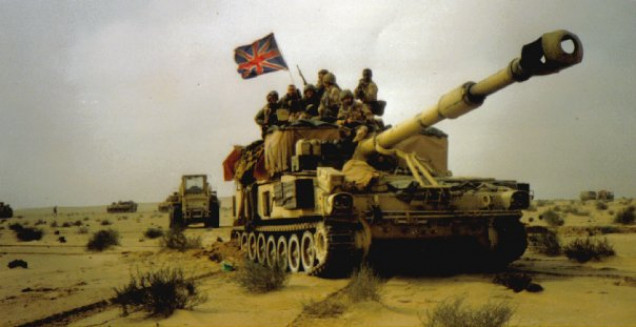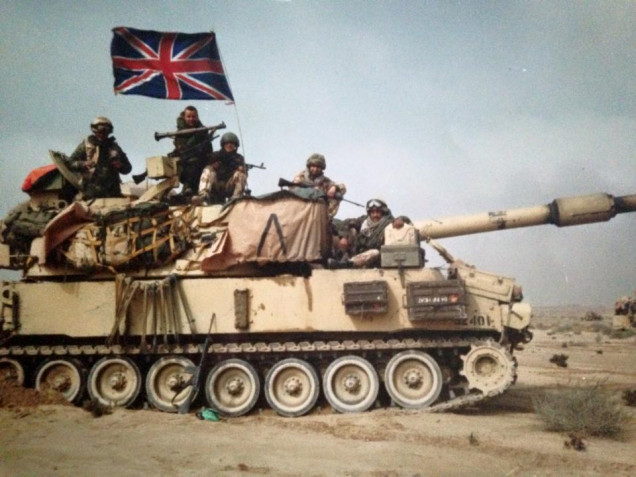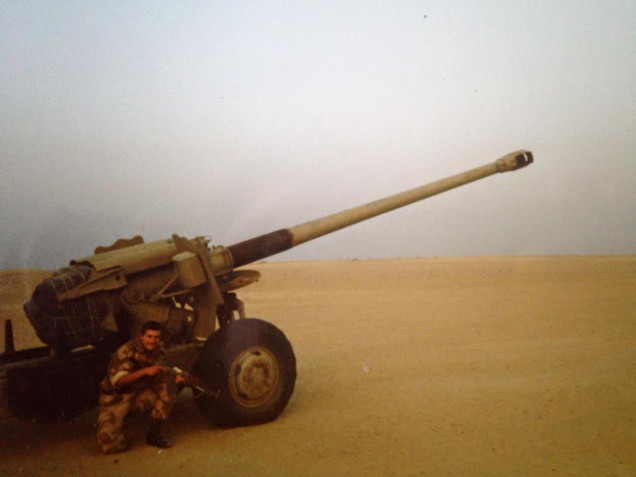
4th Armoured Brigade (Team Yankee)
Gulf War 1990 -1991
I thought I’d take a look at a more recent conflict and one in which I served with the Royal Artillery. Even though the land war was quite short, it does have some scope for tank battles, there is also potential for an alternative history campaign, where by the war didn’t end when it did. The possibility for an extended middle east conflict could be an interesting alternative, with allied forces going into Iraq, and Iran deciding to intervene, and a mirror of the current situation with insurgents.
The Gulf war or as its more commonly known Desert Storm, began on August 2nd when Iraqi forces invaded Kuwait, in a dispute over oil fields. Control of these fields, along with Kuwaiti and Iraqi reserves, would have given Hussein control over the majority of the world’s oil reserves. The allied response, which was to remove Iraqi troops from Kuwait began on January 17th 1991, with aerial bombardment.
I was by this time already in theatre of operations with my artillery unit, based in Saudi waiting to moved up to the front. The biggest threat at this point we faced from Iraqi, were the Scud missiles. There was only one incident when we got air raid warning that a scud had landed near us. We spent the night in NBC kit, sat in a trench, not a comfortable night, I did manage to sleep, though to the amazement of those around me, back then I could anywhere and during any situation. I even managed to sleep through a fire mission during the ground war next the M109 Self propelled gun, once asleep I was like the living dead.
The Gulf War started with an extensive aerial bombing campaign. The coalition flew over 100,000 sorties, dropping 88,500 tons of bombs, and widely destroying military and civilian infrastructure. The air campaign was commanded by USAF Lieutenant General Chuck Horner, who briefly served as Commander-in-Chief – Forward of U.S. Central Command while General Schwarzkopf was still in the United States. (Wikipedia)
Once up near the front we saw on a regular basis the US A-10’s tank buster aircraft carrying numerous sorties. I always remember waking up one morning to the sound of some very low flying aircraft, which included A-10’s and assorted helicopters. These flew over at a very low-level, and a few minutes later we could hear them unloading their payload on to an Iraqi position.
Battle of Khafji
I don’t know much about Khafji, so I’ve included an extract below from a wikipedia article.
On January 29, Iraqi forces attacked and occupied the lightly defended Saudi city of Khafji with tanks and infantry. The Battle of Khafji ended two days later when the Iraqis were driven back by the United States Marine Corps, supported by Saudi and Qatari forces. The allied forces provided close air support and used extensive artillery fire. Casualties were heavy on both sides, although Iraqi forces sustained substantially more dead and captured than the allied forces. Eleven Americans were killed in two separate friendly fire incidents, an additional 14 U.S. airmen were killed when an American AC-130 gunship was shot down by an Iraqi SAM missile, and two American soldiers were captured during the battle. Saudi and Qatari forces had a total of 18 dead. Iraqi forces in Khafji had 60–300 dead and 400 captured. Khafji was a strategically important city immediately after the Iraqi invasion of Kuwait. The Iraqi reluctance to commit several armored divisions to the occupation, and its subsequent use of Khafji as a launching pad into the initially lightly defended east of Saudi Arabia is considered by many academics a grave strategic error. Not only would Iraq have secured a majority of Middle Eastern oil supplies, but it would have found itself better able to threaten the subsequent U.S. deployment along superior defensive lines.
The Ground War
The ground war for us started 10 days before the actual push through the mine fields. We were sent on shoot and scoot fire missions prior to the big push, the aim was to go to set co-ordinates and carry out a fire mission. I’ll never forget that on one occasion, we completed the fire mission, when our right track came off. This became a tense moment, because we had to put the track back on, which is no mean feat, but we were under sever pressure as we could be venerable to counter-battery fire from the Iraqi’s. As far as we were concerned at this point, the Iraqi’s were fully capable of returning artillery fire, so it was quit tense and nerve-racking.
On 24 February, both British and American forces moved through the breach in the mine fields and into Iraq. The breach was basically a long thing road cut through the minefield, all drivers were told not to deviate or they would be in the cack. We went through during the night in convoy, the only way to see the vehicle in front was by the way of a red torch. unfortunately for us the vehicle in front, their torch had gone out, though we didnt;t know this. It couldn’t be seen, so the sensible conclusion was we’ve dropped behind, so speeding seemed the sensible idea. The barrel went straight into the back of a high explosive ammo wagon.
So we moved into our first position and carried out a 50 round fire for effect, the adrenalin was really pumping now and it didn’t go down until after the ground war ended. Most of the guys didn’t sleep during this period and those that did manage to geta few winks, like myself never got a full nights kip. At most positions we were presented with Iraqi prisoners, it seems they were surrendering in their droves. I was on one patrol after entering a new position, when we came across several, they dropped any weapons and threw their hands up, we disarmed them and waited for some MP’s to collect them.
There were several incidents on the gun position during this time, one of which I look back at fondly. We were in down time on the 2nd or 3rd day when an American Humvee turns up, they pulled up and asked for directions. Now these weren’t direction to our HQ, or to another unit nearby, which is what you’d assume, NO, these guys asked if we knew how to get to the front, as they were supposed to be behind Iraqi lines, yep, US special forces, who were lost, LMAO.
The scariest incident happened one night around or close to midnight, we were in the middle of a fire mission, when the order came over the radio, Prepare for Tanks. Even though these were outdated, old russian tanks, they were still extremely dangerous to us poor old Gun Bunnies. They are more maneuverable and better armed than an M109, which meant if they managed to get onto the position we were screwed. As tension and anxiety increased, we waited for inevitable Tank Action, but thankfully it never came, the 17/21st Lancer turned up and saved our bacon, good old tankies. e tense and nerve-racking.
A tankie mate of mine from the 14th/20th Hussar once told me of an incident involving his tank. They had entered an Iraqi Tank position and some how ended up being surrounded by about 5-6 tanks. Thinking their number was up, as the Iraqi tanks fired at the Challenger tank he was sat in, the rounds just bounced off the armour. He said it was a few minutes before realising they were still intact. He then said they slowly took each tank out one after the other, calmly and glad to still be in one piece.
So the ground war ended, one hundred hours after the ground campaign started, on 28 February, President Bush declared a cease-fire, and he also declared that Kuwait had been liberated.
Those 100 hours were intense, adrenalin filled nerve-wracking hours which seemed to last far longer.

































![How To Paint Moonstone’s Nanny | Goblin King Games [7 Days Early Access]](https://images.beastsofwar.com/2024/12/3CU-Gobin-King-Games-Moonstone-Shades-Nanny-coverimage-225-127.jpg)











































Great idea for a project, @warhammergrimace – I’m actually very pleased to see someone else using Team Yankee miniatures to build a force of historical, or even personal, importance. Great photos. Man, you were waaaay closer to anything serious than I ever was. I’m also building a Desert Storm force from Team Yankee, using Ryan’s Leathernecks and other sets to build a 1991 al-Khafji themed US Marine Corps force. Actually my Marines are all done, now I just have to finish Iraqi Army. https://www.beastsofwar.com/project/1454439/ We’ve also been dabbling with Operation Granby / 1991 Gulf War for UK forces in the… Read more »
@Oriskany I really like the US force, nicely painted. The video was interesting to watch, at my club we’ve toyed with playing out some tank battles using the Tanks game. Both WW2 and Modern battles, I even started building some Soviet tanks for this purpose. When Team Yankee came out I was tempted to take the plunge and building a 4th Armored Brigade army seemed like the obvious choice. I was originally going to build it as a desert themed army based around the Desert Storm deployment, but decided at the weekend to go Northern Europe instead. Units will include;… Read more »
@warhammergrimace – Holy crap, your force is gonna be HUGE! I understand your decision to build the force in Northern Europe. Desert Storm is of course “historically relevant” but you gotta paint for games that other players in your group will actually play. I have no illusions – my USMC and Iraqi armored force of mine will probably never see an actual gaming table (the ground war lasted 100 hours, after all), but will be useful if we ever do any Gulf War content on Sitrep Podcast. But damn, even if you only do a sample of each of each… Read more »
It’s going to be a long term project. Especially as I need to source a lot of it. I’ve picked up a metal Challenger but now there are plastic versions by Battlefront I’m switching to plastic. Though other units will have be sourced in metal from a variety of companies.
I have found this company which had a good selection of British vehicles. I may get the MLRS from here.
https://quickreactionforce.co.uk/product/mbi01-modern-british-with-sa80-advancing/